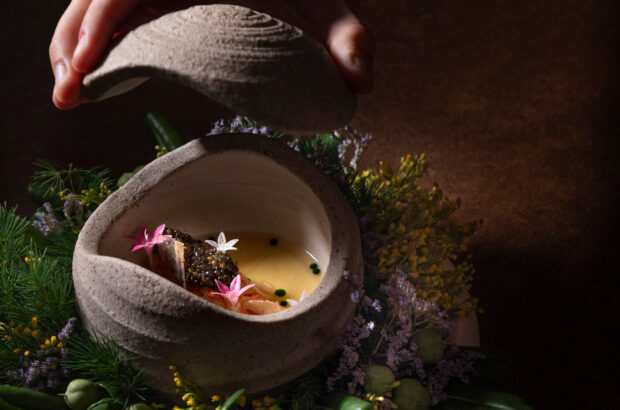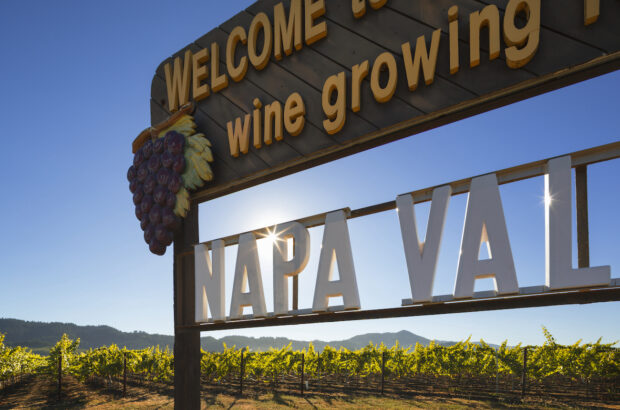Riggs Lokka stands in a seven-foot soil pit on Green Valley’s Hallberg Ranch in Russian River Valley. With a cowboy hat atop his head, he points out the soil types from ground level to the base of the pit. The line of demarcation two feet down is stark. What begins as Goldridge, a sandy loam, becomes bright-orange Sebastopol, a sandy, clay loam. Even more striking, vine roots branch down through both.
Lokka, vineyard manager of Emeritus Vineyards and member of the California Dry-Farming Advisory Board, practices dry-farming.
Digging in the dirt
The practice eschews irrigation and relies solely on rainfall and the natural moisture stored in the soil. Vineyard managers like Lokka help provide a roadmap for California wine-growers with heat and drought-threatened vineyards.
‘We only take what Mother Nature gives us,’ said Lokka. Emeritus proudly holds the title of the largest 100% dry-farmed Pinot Noir estate in Sonoma County.
‘We don’t turn on water. We don’t need it,’ Lokka added. ‘When we first started dry-farming, we saw a reduction in crop load; the vines had not had water. When the water was shut off, the vines grew deeper to find it in the clay soil. Now, the vines are producing 3-3.5 tons per acre (approximately 6.75 metric tonnes per ha) with no problem.’
Vineyard soil and geological makeup are critical to dry-farming success. ‘Goldridge can hold a lot of water, and it’s also very porous, so the roots can easily get down to the [clay], where the water is,’ Lokka said.

Vineyard manager Riggs Lokka at Emeritus Vineyards. Credit: Emeritus Vineyards
A sense of balance
This allows the roots to reach 20 to 30 feet deep with multiple root tendrils, creating a healthier vine that can adapt naturally to major weather shifts. ‘You have to be patient. The vines must determine where water is stored; you can’t force them to find it in the first year. But the complexity of the wines from the fruit will be a better expression of the terroir.’
Watching Lokka in the soil pit conjured up Pedro Parra, the Chilean vineyard consultant renowned for using soil pits to analyse vine efficacy. He takes on very few clients, one of which is Sonoma’s Hamel Family Wines.
Hamel’s Armor Plate Vineyard, planted in the 1880s, still produced 2.75-3 tons per acre (approximately five metric tonnes per ha) with no irrigation when Hamel sold it last year. John Hamel, director of wine-growing, said, ‘The modern vineyard has a 25 to 30-year lifespan, yet Armor was over 120 years old. So, what gave it longevity? The lack of irrigation.’
‘Our vineyards are 80% dry-farmed,’ Hamel said. ‘Despite seasons with lower rainfall, we’ve been consistently meeting or exceeding our historical averages with no meaningful reduction in our output, and we save over two million gallons (7.5 million litres) of water per year.’
Practical challenges
Irrigation has advantages; it’s easier to maintain fruit consistency from vintage to vintage, and while dry-farming may result in higher-quality fruit, it may also decrease quantity. Going irrigation-free is not always an option. Specific rootstocks and soils lend themselves better to the practice than others.
Hamel knows this firsthand. ‘The difficulty in converting our remaining 20% is due to the soil structure. Where the loam consists of high percentages of clay and silt, the areas have a restrictive layer that is somewhat superficial in depth, like unfractured bedrock or a compressed clay layer. Sometimes, we have shallow, silty clay over impermeable bedrock or a clay hardpan, which is the worst combination. These areas likely will never be able to be successfully dry-farmed.’
‘Conversely, the soil structure that is very beneficial for dry-farming has more micro-porosity, consisting of higher percentages of silt, sand, and gravels and having bedrock that is fractured. Without the fractures, there is no path for the roots through the rock.’

John Hamel in the vineyards. Credit: Jimmy Hayes
The role of roots
Hannah Gropman, estate director of Sonoma’s Blue Farm Wines, explains that the current rootstock in use prohibits dry-farming partially because the vineyard was an old riverbed. ‘It holds water quite well, but there’s a hardpan. So, the roots can also only go so deep. It’s too dense; they can’t penetrate it. So, our rootstock is very shallow. As we slowly replant the vineyard, we will use a more deep-rooted system to assist with even less irrigation.’
In addition to the rootstock depth, its vigour is also crucial, according to Lokka. ‘A higher vigour rootstock may not be the best option. At Emeritus, we used 101-14 when we planted, which is a medium-vigour rootstock, and it has worked well under our dry-farmed scenario.’
Without irrigation, berries grow smaller and flavours are more intense. Hamel said before transitioning to dry-farming: ‘We were studying soil pits to understand the terroir, and roots were hovering in the first two or three feet of soil. How would we ever bring terroir into the wine that way?’
One vintage proved to Hamel that holding back water was the answer. ‘In 2021, we had 13 inches (33cm) of rain. I would have said no if you had asked me [before 2021] if it was possible to dry-farm with 13 inches of rain. But our vines had become accustomed to summer drought. We had a lower crop than usual, but everyone did. Ultimately, qualitatively, it’s one of the best vintages we have had.’

Terraced vineyards on Giglio Island. Credit: Layne Randolph
Old news in the Old World
Dry-farming has been a fundamental agricultural practice in dry Mediterranean regions for centuries. Lokka points out that going without irrigation there is easier because ‘they have rain’. However, with climate instability, Europe has had to adapt as well. It’s known for restricting irrigation, yet record-breaking heat means many previously anti-irrigation regions now allow it upon regional consensus.
Other techniques help as well. Aldo Rametta of Emilia-Romagna’s Ronchi di Castelluccio explains that choosing where and what to plant is critical. ‘Our soil, formed by marl and clay, allows for retaining rainwater. Also, most of our cultivation is Sangiovese, which lends itself well to drought areas and releases more fruit power.’
Wine-growers on arid, windswept Giglio Island use terracing, an ancient method that allows the soil to absorb and retain water more effectively, and the island’s rocky subsoil holds onto the moisture. The low canopy of alberello (bush-trained vines) helps capture dew and maintain humidity in the moats around the trunks. Nicola Chiucchiurlotto, owner of Umbria’s Cantina Madrevite, tills between vine rows to allow rain absorption and keep the soil loose in the first few inches so it doesn’t compact and crack.
A honeymoon trip to Champagne almost a decade ago solidified Hamel’s decision to practice dry-farming. ‘I mentioned our irrigation to a producer, and he said: “You might as well have a bunch of potted plants in the field because that’s as close as you’re ever going to get to capturing the terroir.”‘













